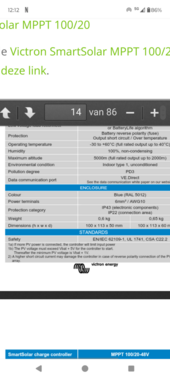2Big2B
Free Wheeler
I would like to see a simple set of guidelines for "How to bench test a Solar Charge Controller without a panel array" - for the general interest and benefit to us Beginners.
I have searched for a concise definitive instruction for how to test a used Solar Charge Controller from ebay to verify it before the Returns Accepted thru <date> runs out. It is a straight forward enough question seeking a not so technical answer. Not how to build a clock, but how to see if it works... Videos after videos seem to elaborate too much or go off in some tangent explanation or scenario.
In my case I have ordered a used Victron 100 30. I do not feel like assembling an array to test it.
I have a variable 24v 1.8a HP desktop power supply that I used for pre charging 3.2v LiFePo4 cells for my 24v 100A DYI BATTERY projects, as well as any number of AC adapter 12v DC power supplies ov various amperages.
All of the discussions I have seen here so far have debated using Regulated power supplies and how they aren't great at mimicking a solar array. Too confusing. I just need to verify that I didn't buy a burned out lemon and that the CC isn't dead. OK ?
Does the type of DC power supply make any difference? -More importantly, as long as polarity and maximum VOC and amperages are respected on hooking up a power supply to the PV input connections, what are some valid voltages/amps and are there any hazards in doing so?
I might want to further experiment later with different voltage/amp power supplies. What if I hook up a 12v car battery to the PV input of a Victron MPPT 100 30 CC ? Or, what if I use the variable power supply's output adjustments to mimick shadows and clouds that an array would be subject to? That way I could probably test to see if the tracking is functional?
I also just got a free Eco-Worthy 12A boost charge controller I might want to test as power supply source ...
Is it ok to do this, or is there a "Gotch'a" I am ignorant about? I am a little nervous about that and my lack of confidence is my biggest hurdle.
So, how about a simple guidelines in testing and experimenting with a new charge controller?
Anyone?
I have searched for a concise definitive instruction for how to test a used Solar Charge Controller from ebay to verify it before the Returns Accepted thru <date> runs out. It is a straight forward enough question seeking a not so technical answer. Not how to build a clock, but how to see if it works... Videos after videos seem to elaborate too much or go off in some tangent explanation or scenario.
In my case I have ordered a used Victron 100 30. I do not feel like assembling an array to test it.
I have a variable 24v 1.8a HP desktop power supply that I used for pre charging 3.2v LiFePo4 cells for my 24v 100A DYI BATTERY projects, as well as any number of AC adapter 12v DC power supplies ov various amperages.
All of the discussions I have seen here so far have debated using Regulated power supplies and how they aren't great at mimicking a solar array. Too confusing. I just need to verify that I didn't buy a burned out lemon and that the CC isn't dead. OK ?
Does the type of DC power supply make any difference? -More importantly, as long as polarity and maximum VOC and amperages are respected on hooking up a power supply to the PV input connections, what are some valid voltages/amps and are there any hazards in doing so?
I might want to further experiment later with different voltage/amp power supplies. What if I hook up a 12v car battery to the PV input of a Victron MPPT 100 30 CC ? Or, what if I use the variable power supply's output adjustments to mimick shadows and clouds that an array would be subject to? That way I could probably test to see if the tracking is functional?
I also just got a free Eco-Worthy 12A boost charge controller I might want to test as power supply source ...
Is it ok to do this, or is there a "Gotch'a" I am ignorant about? I am a little nervous about that and my lack of confidence is my biggest hurdle.
So, how about a simple guidelines in testing and experimenting with a new charge controller?
Anyone?
Last edited:





